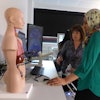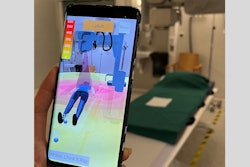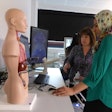Italian radiology residents were generally very satisfied with their training and experiences, with satisfaction increasing progressively with seniority, according to a survey published on 22 November in the European Journal of Radiology.
The survey, conducted by a team headed by Dr. Anna Colarieti of Ospedale Maggiore Della Carità, in Novara, examined radiology residents’ satisfaction with their theoretical education, mentorship, and training experiences.
The survey, which assessed responses from a total of 199 residents from 35 Italian radiology postgraduate schools over the period between 25 September 2023 and 31 January 2024, covered lecture quality, clinical training, mentorship, educational resources, and perceived readiness for independent practice. The participants represented the spectrum of training years; 54% of the respondents were women and 45% were men.
 Colarieti et al; EJR
Colarieti et al; EJR
An average of about 70% of the Italian resident training program is practical, consisting of structured procedural training and rotations in all major imaging modalities -- CT, MRI, conventional and digital radiography, ultrasonography, emergency radiology, angiography, breast imaging, and neuroradiology. Residents are progressively entrusted with responsibilities in the supervision, execution, and interpretation of diagnostic imaging across the modalities, the authors add. The approximately 30% remaining consists of formal teaching by academic faculty; this includes theoretical instruction in the form of lectures and seminars, and mentorship that may include faculty-to-resident or senior-to-junior resident guidance.
Another feature of the resident training program is the widespread availability of international training; the survey included questions concerning international training as well. For international training opportunities, 90% of respondents said that these experiences were available within their programs. Of these respondents, 70% described their participation as “very useful” or “adequate,” which the researchers add highlights the utility of cross-border education in professional development.
 Colarieti et al; EJR
Colarieti et al; EJR
Among the noteworthy findings of the survey, a significant association was found between satisfaction with theoretical instruction and perceived clinical autonomy, with residents rating lectures as “very adequate” also reporting the highest levels of perceived autonomy (29.7%).
Seniority was a factor in both responses: Fourth-year residents showed the highest levels of satisfaction with lectures, with 27.3% rating lectures as “very adequate”; corresponding first- and second-year resident “very adequate” responses were 12.5% and 14.3%, respectively. Fourth-year residents reported the highest perceived sense of preparedness (15.9% "very adequate"), while early-year residents expressed less certainty in their level of preparedness.
On the other hand, the mentorship aspect of the program was rated more highly by less-senior residents, which the authors suggest possibly reflected initial structured support, and then declined in the third year, with some improvement in the fourth year.
Gender differences also showed up in findings: Male residents were more likely to rate theoretical instruction as "very adequate," while female residents were more likely to give neutral or critical ratings. For mentorship, the female residents reported slightly higher dissatisfaction. The authors suggested that “varying expectations for clarity, structure, and feedback in the learning environment, as well as by previous academic experiences and perceived inclusivity in faculty interactions” could be factors in this disparity.
The differences in responses among groups suggest areas where action may be taken: More practical training earlier in the curriculum, improved mentorship structuring, and improved didactic materials.
Most importantly, the authors conclude, “The clear associations identified between perceived educational quality, mentorship, and clinical preparedness highlight the importance of designing training environments that promote early integration of theoretical and practical components, while ensuring consistent access to structured guidance.”
Read the full EJR paper here. For further reading, see this December 2023 article in Diagnostics ("Musculoskeletal Radiology Education: A National Survey by the Italian College of Musculoskeletal Radiology").
















